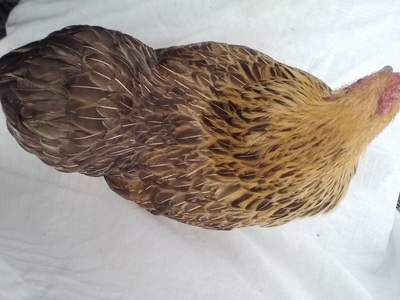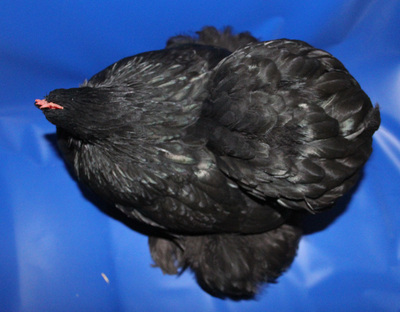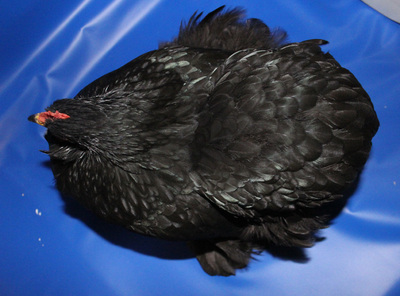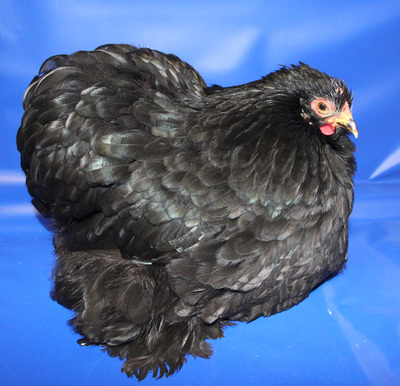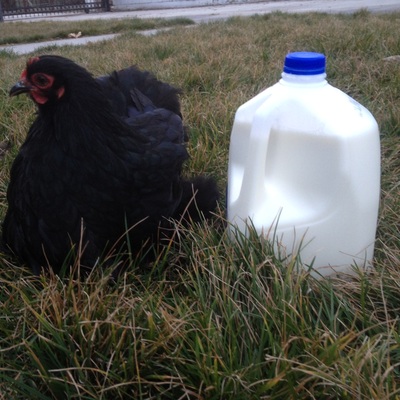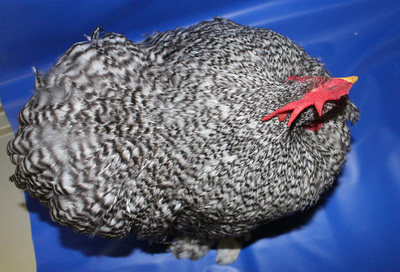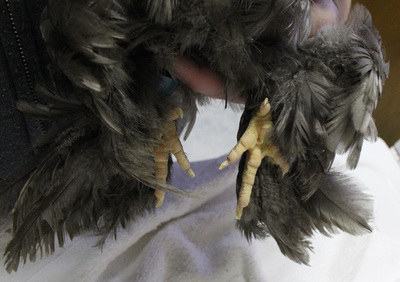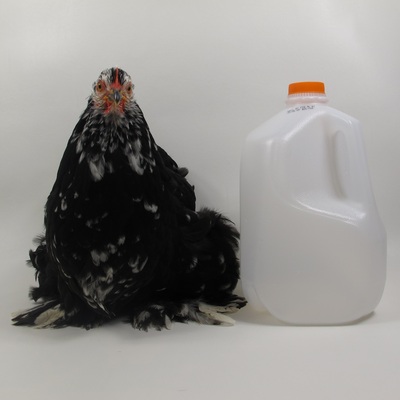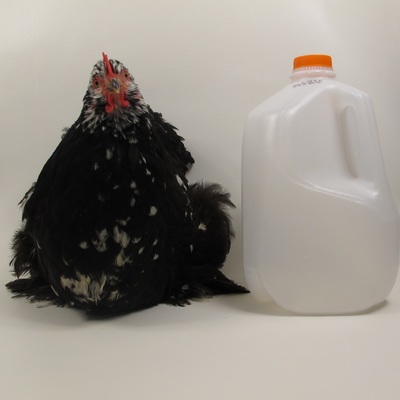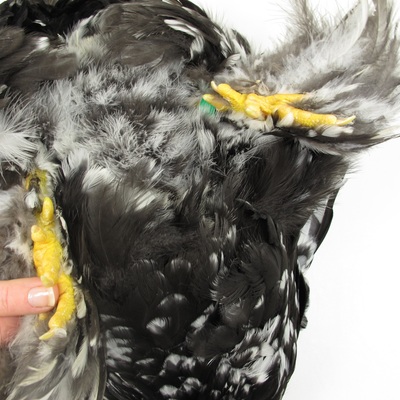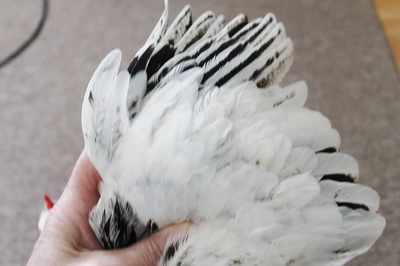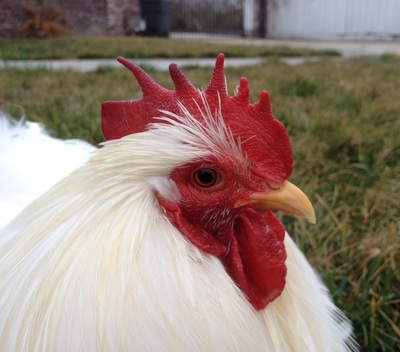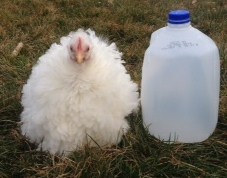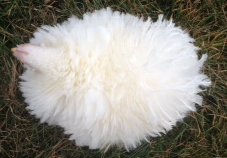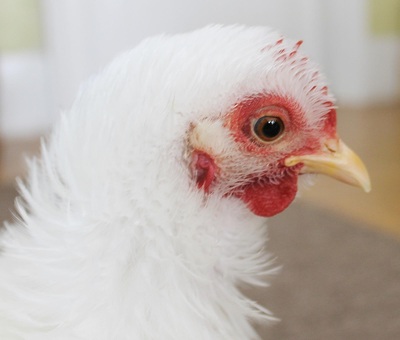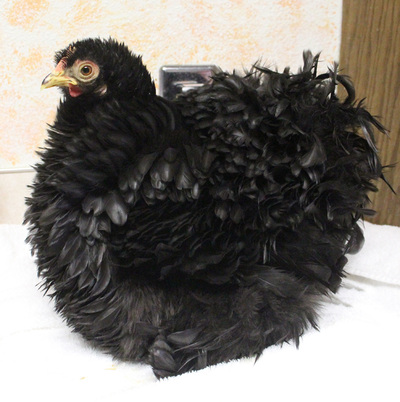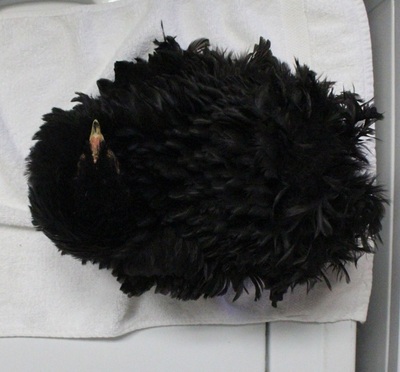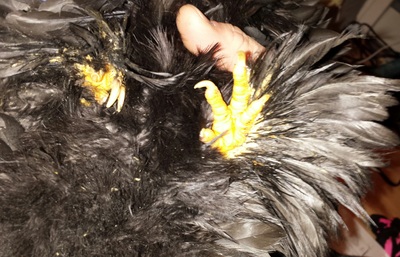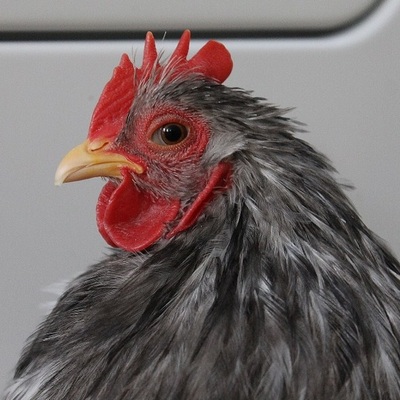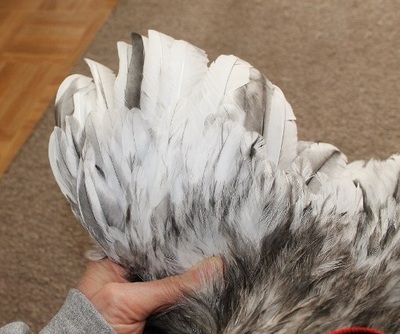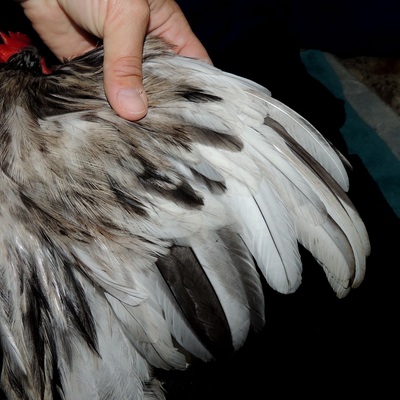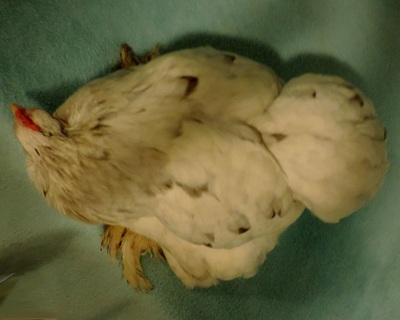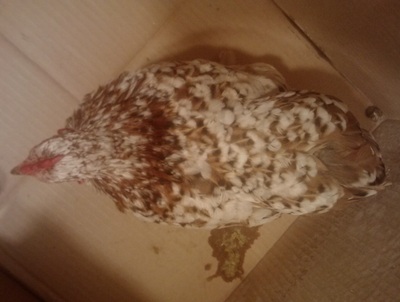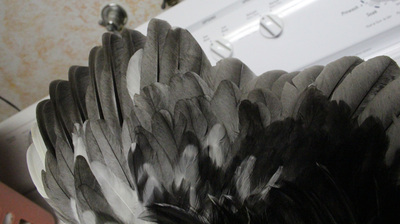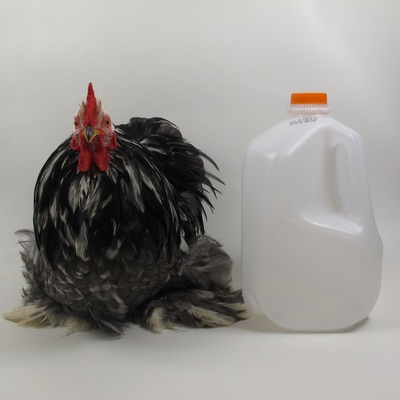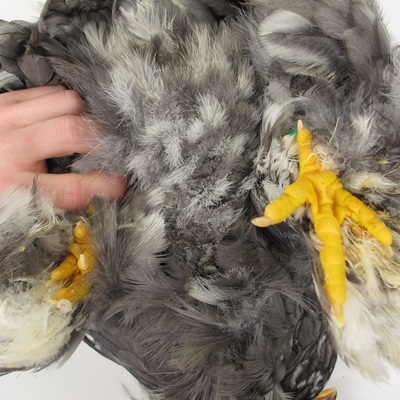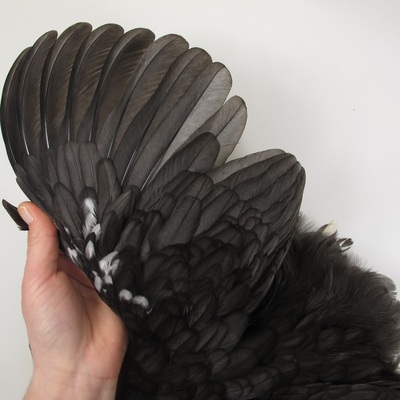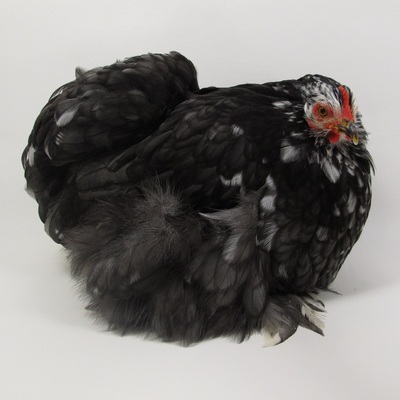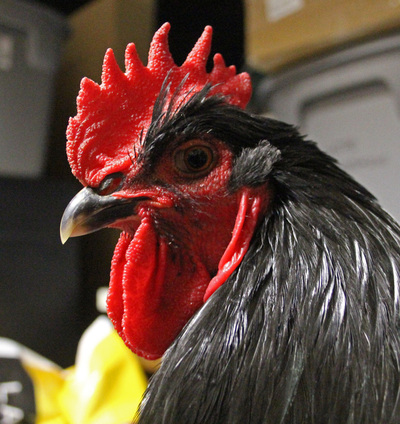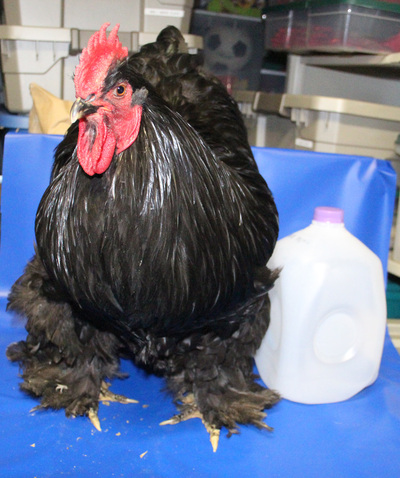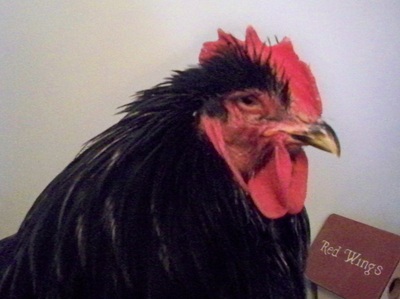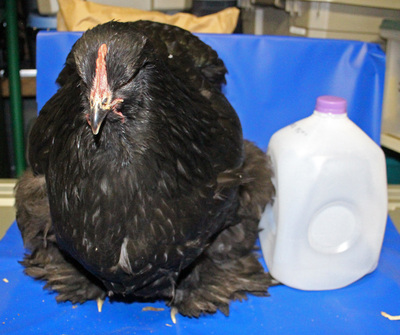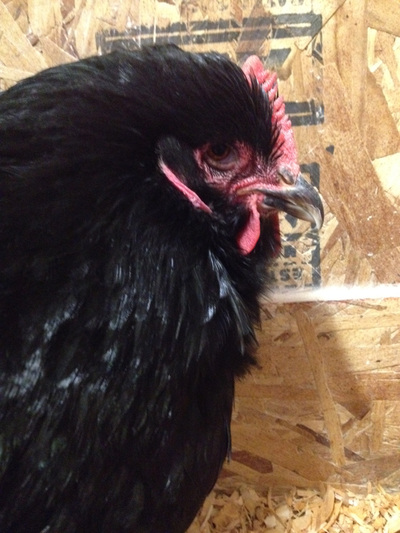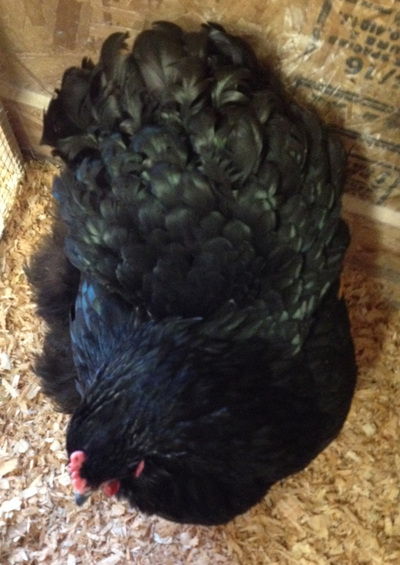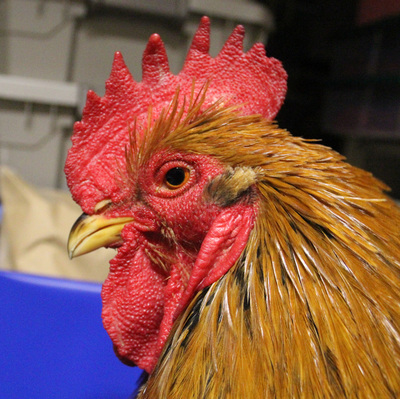Entries for the Winter 2014 Show will be accepted beginning February 1, 2014. The ENTRY DEADLINE is Midnight, February 7, 2014 for both Entry Form (online) and Photo Submission (email).
JUDGE for the Winter 2014 Show will be Robert Anderson.
Photos of all entries will be posted below as they are received. As with normal show Coop Tags, Exhibitor's names will be not shown.
Click on the first photo of each entry - it will enlarge and allow you to scroll through all six pictures.
JUDGE for the Winter 2014 Show will be Robert Anderson.
Photos of all entries will be posted below as they are received. As with normal show Coop Tags, Exhibitor's names will be not shown.
Click on the first photo of each entry - it will enlarge and allow you to scroll through all six pictures.
There are a total of 51 Entries: 45 Bantam and 6 Large Fowl:
Cochins International Winter Show Summary
Prepared by Bob Anderson, Judge
For Gail Carlson, Show Superintendent
February 17, 2014
"Thank you Gail Carlson for organizing the Winter 2014 Online Cochin Show, and thank you to the exhibitors for asking me to assess your birds. One of the strengths of the internet is that it removes the limitations of time and space that would otherwise not allow us to share the experience of showing and learning together. Judging an online show based upon photos can be challenging – taking longer than it would to judge a bird in person because information is limited, size / fleshing is difficult to determine and the view of the bird is dependent upon the skills of the photographer. The extra time, however, also allows the judge to carefully study the birds and provide more detailed comments than would otherwise be provided at a physical show.
The exhibitors should be very proud of the birds entered in this show! There was a record number of entries (51) and the birds were of exceptional composition and in very good condition – clearly most had been washed and prepared for the show.
It is common for exhibitors to prefer certain judges and to refuse to show under others. As a breeder and exhibitor I understand this – the effort that goes into creating a bird that fits your vision, growing it out and then conditioning it for show is undermined when a judge who is not familiar with the breed places birds incorrectly. Some exhibitors will show different styles of birds under different judges – anticipating their preferences. In a perfect world there would not be such differences among judges and their interpretation of the Standard of Perfection. While I do not consider myself infallible by any stretch, I do have a very clear view of what I consider to be a good Cochin based upon input from my mentor, Gary Wilson, as well as my own experience raising almost all recognized varieties of Cochin over the past 35 years. In that vein, my philosophy is that the judging criteria should be on the table – no secrets."
You DO NOT want to miss the rest of Bob's text!! I have posted the entire text on our Education page, but you can also read it here: Cochins International Winter Show Summary
Prepared by Bob Anderson, Judge
For Gail Carlson, Show Superintendent
February 17, 2014
"Thank you Gail Carlson for organizing the Winter 2014 Online Cochin Show, and thank you to the exhibitors for asking me to assess your birds. One of the strengths of the internet is that it removes the limitations of time and space that would otherwise not allow us to share the experience of showing and learning together. Judging an online show based upon photos can be challenging – taking longer than it would to judge a bird in person because information is limited, size / fleshing is difficult to determine and the view of the bird is dependent upon the skills of the photographer. The extra time, however, also allows the judge to carefully study the birds and provide more detailed comments than would otherwise be provided at a physical show.
The exhibitors should be very proud of the birds entered in this show! There was a record number of entries (51) and the birds were of exceptional composition and in very good condition – clearly most had been washed and prepared for the show.
It is common for exhibitors to prefer certain judges and to refuse to show under others. As a breeder and exhibitor I understand this – the effort that goes into creating a bird that fits your vision, growing it out and then conditioning it for show is undermined when a judge who is not familiar with the breed places birds incorrectly. Some exhibitors will show different styles of birds under different judges – anticipating their preferences. In a perfect world there would not be such differences among judges and their interpretation of the Standard of Perfection. While I do not consider myself infallible by any stretch, I do have a very clear view of what I consider to be a good Cochin based upon input from my mentor, Gary Wilson, as well as my own experience raising almost all recognized varieties of Cochin over the past 35 years. In that vein, my philosophy is that the judging criteria should be on the table – no secrets."
You DO NOT want to miss the rest of Bob's text!! I have posted the entire text on our Education page, but you can also read it here: Cochins International Winter Show Summary
Bantam Class / Standard Varieties:
Entry #5 - Partridge Hen: Reserve of Variety by Amanda Myers
"Base color is relatively consistent from the breast to the cushion, good width of skull and wide leg set. This bird could have a deeper mahogany base color, but is better than most Partridge Bantams. The patterning over the cape and cushion shows indistinct penciling and the base color becomes lighter at the edges. I would like to see shorter beak, better width across the cushion, and the wing tucked up and folded properly. Broken feathers in the cushion are a point cut. Missing the outer toenail is not a point cut."
"Base color is relatively consistent from the breast to the cushion, good width of skull and wide leg set. This bird could have a deeper mahogany base color, but is better than most Partridge Bantams. The patterning over the cape and cushion shows indistinct penciling and the base color becomes lighter at the edges. I would like to see shorter beak, better width across the cushion, and the wing tucked up and folded properly. Broken feathers in the cushion are a point cut. Missing the outer toenail is not a point cut."
Entry #8 - Partridge Pullet: Best of Variety by Joanie Fullerton
"Very nice shape for a Partridge Bantam, which tend to be hard feathered. She has nice depth of keel, short wings that are tucked up tight, width of cushion carried all the way through, and abundant feathering around the hock. Bottoms of feet are clear yellow. It appears that this bird is sitting down in these photos, so it is difficult to judge leg length or stance. Regarding color, this bird carries relatively distinct penciling for a pullet – it will improve in her hen year, but needs to have a darker mahogany base color. The breast and cushion should also be the same color, which they aren’t."
"Very nice shape for a Partridge Bantam, which tend to be hard feathered. She has nice depth of keel, short wings that are tucked up tight, width of cushion carried all the way through, and abundant feathering around the hock. Bottoms of feet are clear yellow. It appears that this bird is sitting down in these photos, so it is difficult to judge leg length or stance. Regarding color, this bird carries relatively distinct penciling for a pullet – it will improve in her hen year, but needs to have a darker mahogany base color. The breast and cushion should also be the same color, which they aren’t."
Entry #30 - Partridge Hen:
"This bird is lacking the patterning and mahogany color required of the Partridge color pattern – it more closely resembles the Quail pattern. For breed conformation this bird is lacking in some key areas: (1) The Cochin should have a forward tilt with the cushion balancing the front end, (2) feet are required to be feathered to the last joint of the middle toes and (3) bottoms of the feet should be yellow (allowance given for birds in production. In an open show this bird would be disqualified for lack of breed characteristic – one of the three general disqualifications."
"This bird is lacking the patterning and mahogany color required of the Partridge color pattern – it more closely resembles the Quail pattern. For breed conformation this bird is lacking in some key areas: (1) The Cochin should have a forward tilt with the cushion balancing the front end, (2) feet are required to be feathered to the last joint of the middle toes and (3) bottoms of the feet should be yellow (allowance given for birds in production. In an open show this bird would be disqualified for lack of breed characteristic – one of the three general disqualifications."
Entry #7 - Red Hen: Reserve of Variety by Joanie Fullerton
"Rich color in the hackle, yellow shanks and bird is in good show condition. I would like to see a richer mahogany color which is consistent from breast to tail and over the wings. Regarding type I like the good, wide leg set. I would like to see more forward tilt, a wing that is shorter and tucked up tight, and a wider feather that would prevent holes in the cushion (undercolor showing through) – this is practical in terms of protection from the elements and also makes for a more “finished” looking bird."
"Rich color in the hackle, yellow shanks and bird is in good show condition. I would like to see a richer mahogany color which is consistent from breast to tail and over the wings. Regarding type I like the good, wide leg set. I would like to see more forward tilt, a wing that is shorter and tucked up tight, and a wider feather that would prevent holes in the cushion (undercolor showing through) – this is practical in terms of protection from the elements and also makes for a more “finished” looking bird."
Entry #47 - Red Cock: Best of Variety by Joanie Fullerton
"I very much like the head points of this bird – well proportioned comb, earlobes and wattles with a smooth texture and even serration on the comb. He is also showing wide leg set, bright yellow bottoms of the feet and a rich, dark mahogany color at the cape. Very nice condition. I would like to see that mahogany color carried consistently throughout all sections of the bird. Regarding type, I would like to see more forward tilt so the top of his cushion would align with the top of his head."
"I very much like the head points of this bird – well proportioned comb, earlobes and wattles with a smooth texture and even serration on the comb. He is also showing wide leg set, bright yellow bottoms of the feet and a rich, dark mahogany color at the cape. Very nice condition. I would like to see that mahogany color carried consistently throughout all sections of the bird. Regarding type, I would like to see more forward tilt so the top of his cushion would align with the top of his head."
Entry #9 - Black Pullet:
"Very nice head points, strong wing, and green sheen. This bird is in good show condition and shows vibrant yellow legs. There are holes in the cushion (undercolor showing) which indicates the bird might not be finished, the gap between the primaries and secondaries should be less pronounced and the side-view of the bird should indicate more forward tilt."
"Very nice head points, strong wing, and green sheen. This bird is in good show condition and shows vibrant yellow legs. There are holes in the cushion (undercolor showing) which indicates the bird might not be finished, the gap between the primaries and secondaries should be less pronounced and the side-view of the bird should indicate more forward tilt."
Entry #10 - Black Pullet:
"A well-bred bird with wide feather, abundant feather around the hocks and tight wings held at the horizontal. This bird also shows nice depth of keel and distinctive lines at the back and wing, and has good yellow bottoms of the feet. Show condition is superb, with the bird showing good beetle green sheen. I would like to see this bird with a slightly longer leg, forward tilt and more stout beak."
"A well-bred bird with wide feather, abundant feather around the hocks and tight wings held at the horizontal. This bird also shows nice depth of keel and distinctive lines at the back and wing, and has good yellow bottoms of the feet. Show condition is superb, with the bird showing good beetle green sheen. I would like to see this bird with a slightly longer leg, forward tilt and more stout beak."
Entry #11 - Black Pullet: Reserve of Variety by Ciera Walters
"Very good depth of body, short wing held tightly to the horizontal, good feathering around the hock good coverage over the cushion. This bird is in good show condition – clean, with emerald green sheen and no visible broken feathers. I would like to see more forward tilt and a wing that spreads like a fan with no gap between the primaries and secondaries."
"Very good depth of body, short wing held tightly to the horizontal, good feathering around the hock good coverage over the cushion. This bird is in good show condition – clean, with emerald green sheen and no visible broken feathers. I would like to see more forward tilt and a wing that spreads like a fan with no gap between the primaries and secondaries."
Entry #12 - Black Pullet:
"Good forward tilt (i.e., top of head at or below top of cushion), depth of body and fullness of wing when open. While this bird shows good emerald sheen and is clean, she loses condition points for “holes in the cushion” – apparently missing feathers which allows the undercolor to be visible. Her wing is also held below the horizontal, which is not desirable. Based upon the white feathers around the eyes it is likely this bird is heterozygous for mottling."
"Good forward tilt (i.e., top of head at or below top of cushion), depth of body and fullness of wing when open. While this bird shows good emerald sheen and is clean, she loses condition points for “holes in the cushion” – apparently missing feathers which allows the undercolor to be visible. Her wing is also held below the horizontal, which is not desirable. Based upon the white feathers around the eyes it is likely this bird is heterozygous for mottling."
Entry #22 - Black Pullet:
"Good fullness of feather, width carried all the way through the cushion and superb wing – opens like a fan without any gaps. This bird is in good show condition – full feather, clean and with emerald green sheen. It is difficult to judge leg length and stance based upon the fact that she appears to be sitting. I would like to see a shorter wing held tightly to the body – giving those distinctive lines that separate the cushion from the hock feathering."
"Good fullness of feather, width carried all the way through the cushion and superb wing – opens like a fan without any gaps. This bird is in good show condition – full feather, clean and with emerald green sheen. It is difficult to judge leg length and stance based upon the fact that she appears to be sitting. I would like to see a shorter wing held tightly to the body – giving those distinctive lines that separate the cushion from the hock feathering."
Entry #23 - Black Pullet: GRAND CHAMPION OF SHOW, CHAMPION STANDARD BANTAM, Best of Variety by Edison Cigany
"Superb specimen. Good length of leg, forward tilt, short wing pulled above the horizontal and distinctive top line. She carries her width all the way through the cushion, which is fully covered – not showing any undercolor. Improvement areas would be slightly deeper keel, more stout beak, and a wing that opens with no gap between the primaries and secondaries."
"Superb specimen. Good length of leg, forward tilt, short wing pulled above the horizontal and distinctive top line. She carries her width all the way through the cushion, which is fully covered – not showing any undercolor. Improvement areas would be slightly deeper keel, more stout beak, and a wing that opens with no gap between the primaries and secondaries."
Entry #27 - Black Pullet:
"It is difficult to properly evaluate this bird as she appears to be missing a large portion of feathers in the cushion. Based upon what I can see she has good stance, deep keel and a wing that is pulled above the horizontal. I would like to see her width carried through the cushion, a shorter beak and less gap between the primaries and secondaries when the wing is open."
"It is difficult to properly evaluate this bird as she appears to be missing a large portion of feathers in the cushion. Based upon what I can see she has good stance, deep keel and a wing that is pulled above the horizontal. I would like to see her width carried through the cushion, a shorter beak and less gap between the primaries and secondaries when the wing is open."
Entry #49 - Black Pullet:
"This bird is in good condition, and shows very good finish and emerald green sheen, which may be due to having a slightly harder feather than most Cochins. Feet are bright yellow. I would like to see a deeper body, shorter wing held tightly to the body, and greater width across the back and cushion."
"This bird is in good condition, and shows very good finish and emerald green sheen, which may be due to having a slightly harder feather than most Cochins. Feet are bright yellow. I would like to see a deeper body, shorter wing held tightly to the body, and greater width across the back and cushion."
Entry #25 - Black Cock: Best of Opposite Sex by Abby Cromwell
"A good representative of the breed – deep in the body, full in the hackle and with good forward tilt. Good width of skull and good width of body carried through the cushion. The most important area for improvement should be a shorter wing held tight to the body so the saddles hang over. The cushion is not in full bloom, so some undercolor is showing through. Minor improvement areas – less duskiness in the shank and more substantial points on the comb."
"A good representative of the breed – deep in the body, full in the hackle and with good forward tilt. Good width of skull and good width of body carried through the cushion. The most important area for improvement should be a shorter wing held tight to the body so the saddles hang over. The cushion is not in full bloom, so some undercolor is showing through. Minor improvement areas – less duskiness in the shank and more substantial points on the comb."
Entry #37 - Black Cockerel:
"Good emerald green sheen, long saddles, long foot feathering and good show condition. This bird has reasonable width of cushion, but lacks width and depth at the front-end. Wing is long and carried well below the horizontal. Based on the white feathers around the eye it is likely that this male is heterozygous for mottling."
"Good emerald green sheen, long saddles, long foot feathering and good show condition. This bird has reasonable width of cushion, but lacks width and depth at the front-end. Wing is long and carried well below the horizontal. Based on the white feathers around the eye it is likely that this male is heterozygous for mottling."
Entry #50 - Black Cockerel:
"Good emerald sheen, good show condition, strong wing when spread and good yellow bottoms of the feet. I like his head points – comb, beak and length of wattle. This male is full in the hackle, but loses width at the cushion. I would like to see deeper keel and a shorter wing pulled up to the horizontal so the saddle hang over."
"Good emerald sheen, good show condition, strong wing when spread and good yellow bottoms of the feet. I like his head points – comb, beak and length of wattle. This male is full in the hackle, but loses width at the cushion. I would like to see deeper keel and a shorter wing pulled up to the horizontal so the saddle hang over."
Entry #13 - Barred Cockerel: Best of Variety by Ciera Walters
"Good full hackle, width of back and foot feathering. There appears to be clear distinction between the black and white bars with no indication of brown. Feet are clear yellow. I would like to see a deeper keel, forward tilt and shorter wing held at the horizontal underneath the saddle. Saddle feathers are not fully in, causing some undercolor to show."
"Good full hackle, width of back and foot feathering. There appears to be clear distinction between the black and white bars with no indication of brown. Feet are clear yellow. I would like to see a deeper keel, forward tilt and shorter wing held at the horizontal underneath the saddle. Saddle feathers are not fully in, causing some undercolor to show."
Entry #19 - Blue Pullet: Best of Variety by Ciera Walters
"It is difficult to tell stance or length of leg as the bird appears to be sitting in these photos. This bird shows good width carried through the cushion, strong foot feathering and strong wing with no gaps. Condition is good, although she may not be completely dry in these photos. The base blue color is very good – clear and consistent, cool without any warm tones, streaking or mealiness. I would like to see a forward tilt with head level with or slightly below the cushion, shorter wing held more tightly to the body and less shafting. Icing on the cake would be deeper edging / lacing on the feathers."
"It is difficult to tell stance or length of leg as the bird appears to be sitting in these photos. This bird shows good width carried through the cushion, strong foot feathering and strong wing with no gaps. Condition is good, although she may not be completely dry in these photos. The base blue color is very good – clear and consistent, cool without any warm tones, streaking or mealiness. I would like to see a forward tilt with head level with or slightly below the cushion, shorter wing held more tightly to the body and less shafting. Icing on the cake would be deeper edging / lacing on the feathers."
Entry #32 - Mottled Pullet:
"A sound bird in good condition with emerald green sheen. Good length of leg and abundant feathering around the hock. I would like to see this bird carry more width, a shorter & wider head / shorter beak, and shorter wing. The open wing shows secondaries with a tendency to bunch together near the body rather than spread."
"A sound bird in good condition with emerald green sheen. Good length of leg and abundant feathering around the hock. I would like to see this bird carry more width, a shorter & wider head / shorter beak, and shorter wing. The open wing shows secondaries with a tendency to bunch together near the body rather than spread."
Entry #41 - Mottled Pullet: Best of Opposite Sex by Sarah Eddy
"Good width and depth, strong wing pulled up tight above the horizontal and is solid when open without any gaps; abundant feather around the hocks and yellow bottoms of feet. I like the head structure, although the beak could be more stout. I would like to see a slightly longer leg on this bird and a more forward stance. The webbing of her feathers over the cushion appears to break down, which gives an unfinished appearance and allows the undercolor to show through. Continue to work on mottling that is evenly spread across the entire bird and is distinctively marked in the shape of a white tear drop."
"Good width and depth, strong wing pulled up tight above the horizontal and is solid when open without any gaps; abundant feather around the hocks and yellow bottoms of feet. I like the head structure, although the beak could be more stout. I would like to see a slightly longer leg on this bird and a more forward stance. The webbing of her feathers over the cushion appears to break down, which gives an unfinished appearance and allows the undercolor to show through. Continue to work on mottling that is evenly spread across the entire bird and is distinctively marked in the shape of a white tear drop."
Entry #33 - Mottled Cockerel: Reserve of Variety by Sarah Eddy
"Good condition and emerald green sheen, with mottling relatively distinct and well-distributed. This male as very good wing carriage for a Cochin Bantam – tucked up tight underneath the saddle. Good overall head structure, although the upper beak could use some filing and the blade of the comb is what is known as a “fish tail”. Strong wing and good yellow leg color. Overall I would like to see this bird with a deeper keel and more forward tilt, as well as a more pronounced cushion to balance the front end."
"Good condition and emerald green sheen, with mottling relatively distinct and well-distributed. This male as very good wing carriage for a Cochin Bantam – tucked up tight underneath the saddle. Good overall head structure, although the upper beak could use some filing and the blade of the comb is what is known as a “fish tail”. Strong wing and good yellow leg color. Overall I would like to see this bird with a deeper keel and more forward tilt, as well as a more pronounced cushion to balance the front end."
Entry #43 - Mottled Cockerel: Best of Variety by Sarah Eddy
"A good representation of a Mottled Cochin – good length of leg, depth of body, and width carried all the way through the cushion. Very balanced from front to back, strong wing and good yellow leg color. The webs of the feathers break down at the lesser sickles, giving an unfinished appearance and allowing the undercolor to show through. I would like to see the wing pulled up just a little higher, and more distinct white tear-drop shaped markings spread evenly across the bird."
"A good representation of a Mottled Cochin – good length of leg, depth of body, and width carried all the way through the cushion. Very balanced from front to back, strong wing and good yellow leg color. The webs of the feathers break down at the lesser sickles, giving an unfinished appearance and allowing the undercolor to show through. I would like to see the wing pulled up just a little higher, and more distinct white tear-drop shaped markings spread evenly across the bird."
Entry #39 - Columbian Pullet: Best of Variety by Joanie Fullerton
"It is difficult to evaluate leg length and stance as the bird appears to be sitting down. This bird is in good show condition – clean and in full feather – and she carries her width through the cushion. Good foot feathering and abundant feathering around the hock. She appears to have a weak or slipped wing on one side. The Columbian pattern is not distinct – mossiness in the cushion and too much white in the primaries; white and black often inter-mingling instead of a clean demarcation between the colors."
"It is difficult to evaluate leg length and stance as the bird appears to be sitting down. This bird is in good show condition – clean and in full feather – and she carries her width through the cushion. Good foot feathering and abundant feathering around the hock. She appears to have a weak or slipped wing on one side. The Columbian pattern is not distinct – mossiness in the cushion and too much white in the primaries; white and black often inter-mingling instead of a clean demarcation between the colors."
Entry #48 - White Cock: Best of Variety by Abby Cromwell
"This bird shows an abundance of hackle and long saddle. The top view shows balance from front to back, with width carried all the way through the cushion; long foot feathers are visible. Nice comb and head points; file upper beak before showing. This bird is too short in the leg and shallow in the keel, giving the impression that he is always sitting. He is not quite out of his molt, which shows in the wing as well as the roughness of the cushion."
"This bird shows an abundance of hackle and long saddle. The top view shows balance from front to back, with width carried all the way through the cushion; long foot feathers are visible. Nice comb and head points; file upper beak before showing. This bird is too short in the leg and shallow in the keel, giving the impression that he is always sitting. He is not quite out of his molt, which shows in the wing as well as the roughness of the cushion."
Entry #21 - White Frizzle Pullet: RESERVE CHAMPION STANDARD BANTAM, Best of Variety by Craig Hansen
"A very nice representation of the breed in very good condition. The cushion is full, balancing the front half of the bird, she is clean and white with good frizzling. Wings are carried tight above the horizontal and she has profuse feathering around the hock. I would like to see a slightly longer leg and forward tilt, shorter wing and shorter beak."
"A very nice representation of the breed in very good condition. The cushion is full, balancing the front half of the bird, she is clean and white with good frizzling. Wings are carried tight above the horizontal and she has profuse feathering around the hock. I would like to see a slightly longer leg and forward tilt, shorter wing and shorter beak."
Entry #24 - White Frizzle Pullet:
"This pullet is relatively well balanced and the top view shows that she carries her width through the cushion. She is in good show condition – clean white and almost fully feathered, with the exception of the wing. I would like to see a slightly longer leg, forward tilt with more pronounced cushion, and stronger feathering on the middle toe."
"This pullet is relatively well balanced and the top view shows that she carries her width through the cushion. She is in good show condition – clean white and almost fully feathered, with the exception of the wing. I would like to see a slightly longer leg, forward tilt with more pronounced cushion, and stronger feathering on the middle toe."
Entry #38 - White Frizzle Hen: Reserve of Variety by Joanie Fullerton
"This bird has been very well prepared for the show – bright white and in top condition. She is a relatively small bird with good frizzling and strong wing. I would like to see a slightly longer leg and forward tilt in conjunction with a fuller cushion to balance the front of the bird. Pay attention to feather quality – primary feathers should have enough substance so a newspaper could not be read through them."
"This bird has been very well prepared for the show – bright white and in top condition. She is a relatively small bird with good frizzling and strong wing. I would like to see a slightly longer leg and forward tilt in conjunction with a fuller cushion to balance the front of the bird. Pay attention to feather quality – primary feathers should have enough substance so a newspaper could not be read through them."
Entry #17 - Black Frizzle Pullet: Best of Variety by Ciera Walters
"Overall nice shape with good balance front to back. The bird is in good show condition – healthy and clean with no broken feathers, except maybe in the wing. Good foot feather, yellow feet and abundance of feather around the hock. I would like to see a shorter, stronger wing on this bird – it is not pulled up to the horizontal when standing and appears to show gaps when open."
"Overall nice shape with good balance front to back. The bird is in good show condition – healthy and clean with no broken feathers, except maybe in the wing. Good foot feather, yellow feet and abundance of feather around the hock. I would like to see a shorter, stronger wing on this bird – it is not pulled up to the horizontal when standing and appears to show gaps when open."
Entry #31 - Black Frizzle Pullet: Reserve of Variety by Joanie Fullerton
"Overall good balance from front to back, width is carried through the cushion and feet are clear yellow. This bird is in good show condition – healthy, clean and in full feather. This bird appears to have a weak wing on one side as it does not fold properly when the bird is standing naturally. I would like to see higher density of feathers in the cushion."
"Overall good balance from front to back, width is carried through the cushion and feet are clear yellow. This bird is in good show condition – healthy, clean and in full feather. This bird appears to have a weak wing on one side as it does not fold properly when the bird is standing naturally. I would like to see higher density of feathers in the cushion."
Entry #51 - Black Frizzle Pullet:
"It is difficult to evaluate leg length and stance as the bird appears to be sitting down in these photos. She is in good show condition – healthy, clean and in feather. Feet are clear yellow. I would like to see a stronger wing pulled up tight when she is standing naturally; the open wing shows secondaries bunched up near the body. Beak could be shorter and the comb is not straight."
"It is difficult to evaluate leg length and stance as the bird appears to be sitting down in these photos. She is in good show condition – healthy, clean and in feather. Feet are clear yellow. I would like to see a stronger wing pulled up tight when she is standing naturally; the open wing shows secondaries bunched up near the body. Beak could be shorter and the comb is not straight."
Entry #26 - Black Frizzle Hen:
"Good balance front to back, reasonable width across the back and good width of skull. This bird shows good frizzling and is in good show condition. It is difficult to assess the open wing as it appears it may not be fully open. I would like to see a longer leg with forward tilt and more fullness in the cushion. From the photos is appears the toes may not be feathered to the last joint of the middle toe."
"Good balance front to back, reasonable width across the back and good width of skull. This bird shows good frizzling and is in good show condition. It is difficult to assess the open wing as it appears it may not be fully open. I would like to see a longer leg with forward tilt and more fullness in the cushion. From the photos is appears the toes may not be feathered to the last joint of the middle toe."
Bantam Class / Non-Standard Varieties:
Entry #1 - Splash Cockerel:
"Good width carried well through the cushion, no gaps in the wing and good yellow leg color. Splash coloring is relatively evenly distributed. The bird is in good show condition – full feather and clean. This cockerel lacks depth of keel and stands too high in the front, wing is carried below the horizontal and feathering around the hock is lacking. Too much brassy color in the hackle and saddle."
"Good width carried well through the cushion, no gaps in the wing and good yellow leg color. Splash coloring is relatively evenly distributed. The bird is in good show condition – full feather and clean. This cockerel lacks depth of keel and stands too high in the front, wing is carried below the horizontal and feathering around the hock is lacking. Too much brassy color in the hackle and saddle."
Entry #20 - Splash Cockerel: RESERVE AOV BANTAM, Best of Variety by Joanie Fullerton
"This bird is a bit young to judge properly – still needing to fill out in the keel and width. Having said that, this is a bird of great value as a breeder and potentially as a show bird. What I notice immediately is that he is the clearest, coolest color – no indication of brown, orange, straw or other autumn tones. His wing shows good width of primaries and secondaries, and his comb, although not showing five points, is smooth and evenly serrated with a clean blade. This bird should show a deeper keel, forward stance and should pull his wing up to the horizontal."
"This bird is a bit young to judge properly – still needing to fill out in the keel and width. Having said that, this is a bird of great value as a breeder and potentially as a show bird. What I notice immediately is that he is the clearest, coolest color – no indication of brown, orange, straw or other autumn tones. His wing shows good width of primaries and secondaries, and his comb, although not showing five points, is smooth and evenly serrated with a clean blade. This bird should show a deeper keel, forward stance and should pull his wing up to the horizontal."
Entry #2 - Splash Cock:
"This bird shows nice balance front to back from the side view, although I would like to see a flat shoulder before the rise at the cushion. The open wing shows no gaps and the bottoms of the feet are clear yellow. A rule of thumb for all patterned birds is that the pattern should be consistent and evenly distributed – this bird shows a noticeable copper cast to the hackle. Would like to see the width carried all the way through the cushion, better feather quality in the cushion (e.g., webs not breaking down / undercolor not showing through) and wing pulled up to the horizontal."
"This bird shows nice balance front to back from the side view, although I would like to see a flat shoulder before the rise at the cushion. The open wing shows no gaps and the bottoms of the feet are clear yellow. A rule of thumb for all patterned birds is that the pattern should be consistent and evenly distributed – this bird shows a noticeable copper cast to the hackle. Would like to see the width carried all the way through the cushion, better feather quality in the cushion (e.g., webs not breaking down / undercolor not showing through) and wing pulled up to the horizontal."
Entry #3 - Splash Hen:
"Good depth of keel, good wing carriage – pulled up tight above the horizontal, and nice comb. Bottoms of the feet are strong yellow, and the overall size of this hen is good. This bird does not fill out in the cushion properly – causing an imbalance between front and back in the side view and a classic “bunny tail” from the top view. Condition is good except for the foot feathering, which indicates the bird has been in outdoor conditions or wet shavings. Beak is long."
"Good depth of keel, good wing carriage – pulled up tight above the horizontal, and nice comb. Bottoms of the feet are strong yellow, and the overall size of this hen is good. This bird does not fill out in the cushion properly – causing an imbalance between front and back in the side view and a classic “bunny tail” from the top view. Condition is good except for the foot feathering, which indicates the bird has been in outdoor conditions or wet shavings. Beak is long."
Entry #4 - Splash Hen:
"This hen is well balanced front to back, the comb is evenly serrated, wing is strong when opened and the bird shows good foot feathering. The feather quality in the cushion – which is epistatic to (linked to) the Splash color pattern – is a deal breaker. It does not allow the bird to finish properly in the cushion for show and is also highly genetic."
"This hen is well balanced front to back, the comb is evenly serrated, wing is strong when opened and the bird shows good foot feathering. The feather quality in the cushion – which is epistatic to (linked to) the Splash color pattern – is a deal breaker. It does not allow the bird to finish properly in the cushion for show and is also highly genetic."
Entry #40 - Splash Pullet: Reserve of Variety by Stephanie Kendall
"Overall a very nice pullet. I like her width of feather, tight wing and cool splash color – clear of any warm / copper tones. She is nice condition, clean and with no broken feathers – although maybe a bit young. Good yellow leg color. Open wing shows a gap between the primaries and secondaries."
"Overall a very nice pullet. I like her width of feather, tight wing and cool splash color – clear of any warm / copper tones. She is nice condition, clean and with no broken feathers – although maybe a bit young. Good yellow leg color. Open wing shows a gap between the primaries and secondaries."
Entry #6 - Mille Fleur Hen: Best of Variety by Amanda Myers
"Mille Fleur is a very complicated pattern and very new to Cochins. It requires a chevron black V and white teardrop at the end of each feather. This bird is relatively well balanced from front to back and shows a strong wing held at horizontal. I would like to see a deeper keel, more width and more distinct coloring."
"Mille Fleur is a very complicated pattern and very new to Cochins. It requires a chevron black V and white teardrop at the end of each feather. This bird is relatively well balanced from front to back and shows a strong wing held at horizontal. I would like to see a deeper keel, more width and more distinct coloring."
Entry #29 - Mille Fleur Hen: Reserve of Variety by Amanda Myers
"This bird is relatively balanced from front to back, holds her wing at horizontal and the beak is relatively stout. Regarding the head points, the comb is not evenly serrated and length of wattle is not sufficient. She is in reasonable show condition – clean, in full feather and no obvious broken feathers – except for the foot feathering, which needs to be washed. The overall Mille Fleur coloring is poor and inconsistent (e.g., breast and cushion are different colors), which is a point cut per section. In this case the base color is too light and appears to carry a dilute (e.g., citroen/cream or genes associated with Buff) and the black chevron V and white teardrop tip are indistinct."
"This bird is relatively balanced from front to back, holds her wing at horizontal and the beak is relatively stout. Regarding the head points, the comb is not evenly serrated and length of wattle is not sufficient. She is in reasonable show condition – clean, in full feather and no obvious broken feathers – except for the foot feathering, which needs to be washed. The overall Mille Fleur coloring is poor and inconsistent (e.g., breast and cushion are different colors), which is a point cut per section. In this case the base color is too light and appears to carry a dilute (e.g., citroen/cream or genes associated with Buff) and the black chevron V and white teardrop tip are indistinct."
Entry #28 - Mille Fleur Cock:
"This bird is lacking the fullness of feather, balance and forward stance required of a Cochin – in other words lacking breed characteristics, one of three general disqualifications in the APA Standard of Perfection. In addition, his foot feathering does not extend to the last joint of the middle toe – a breed-specific disqualification."
"This bird is lacking the fullness of feather, balance and forward stance required of a Cochin – in other words lacking breed characteristics, one of three general disqualifications in the APA Standard of Perfection. In addition, his foot feathering does not extend to the last joint of the middle toe – a breed-specific disqualification."
Entry #18 - Blue Mottled Cockerel:
"This bird is well-balanced front to back, shows good width carried through the cushion and strong wings. The blue base color is clear and consistent, showing no autumn tones, but the mottling is neither evenly distributed nor distinct. I would like to see a deeper keel, more pronounced cushion with more abundant lesser sickles and a shorter wing pulled up tight beneath the saddle."
"This bird is well-balanced front to back, shows good width carried through the cushion and strong wings. The blue base color is clear and consistent, showing no autumn tones, but the mottling is neither evenly distributed nor distinct. I would like to see a deeper keel, more pronounced cushion with more abundant lesser sickles and a shorter wing pulled up tight beneath the saddle."
Entry #35 - Blue Mottled Cockerel: Reserve of Variety by Sarah Eddy
"This bird is well-balanced from front to back, has a strong wing pulled up to the horizontal, and good head points – proportionate earlobes/wattles, stout beak, wide skull and well-serrated comb. He also shows abundant feathering around the hick and an abundance of long foot feathers. Bottoms of feet are bright yellow. This bird is in good show condition – clean, in full feather and no obvious broken feathers – except for some staining on the foot feathering. I would like to see greater depth of body, more defined top line, more refined texture to the comb/ solid blade, and better spread to the secondary feathers."
"This bird is well-balanced from front to back, has a strong wing pulled up to the horizontal, and good head points – proportionate earlobes/wattles, stout beak, wide skull and well-serrated comb. He also shows abundant feathering around the hick and an abundance of long foot feathers. Bottoms of feet are bright yellow. This bird is in good show condition – clean, in full feather and no obvious broken feathers – except for some staining on the foot feathering. I would like to see greater depth of body, more defined top line, more refined texture to the comb/ solid blade, and better spread to the secondary feathers."
Entry #34 - Blue Mottled Pullet: THIRD BEST IN SHOW, CHAMPION AOV BANTAM, Best of Variety by Sarah Eddy
"Good width carried through the cushion, wing held tight at the horizontal and abundant feathering around the hock. This bird is in good show condition – clean, in full feather and no obvious broken feathers. Bottoms of the feet are clear yellow. The base blue color is consistent blue with steel blue neck feathers and no hint of autumn tones. I would like to see the mottling pattern more evenly spread / more distinct, better spread to the secondary feathers, and shorter, wider head with longer wattles."
"Good width carried through the cushion, wing held tight at the horizontal and abundant feathering around the hock. This bird is in good show condition – clean, in full feather and no obvious broken feathers. Bottoms of the feet are clear yellow. The base blue color is consistent blue with steel blue neck feathers and no hint of autumn tones. I would like to see the mottling pattern more evenly spread / more distinct, better spread to the secondary feathers, and shorter, wider head with longer wattles."
Entry #36 - Blue Mottled Pullet:
"Strong wing pulled up to the horizontal, open wing shows secondaries well-spread, and bottoms of feet yellow. The overall visual of this bird is long and shallow – that applies to the body, where I would like to see deeper keel/longer leg as well as the head where I would like to see greater width, shorter beak and longer wattle. Cushion is under-developed, creating the classic “bunny tail”, both from the side and top view."
"Strong wing pulled up to the horizontal, open wing shows secondaries well-spread, and bottoms of feet yellow. The overall visual of this bird is long and shallow – that applies to the body, where I would like to see deeper keel/longer leg as well as the head where I would like to see greater width, shorter beak and longer wattle. Cushion is under-developed, creating the classic “bunny tail”, both from the side and top view."
Entry #42 - Blue Mottled Pullet:
"Good length of leg/depth of body, width carried through the cushion and strong wing – carried at the horizontal when folded and no gaps between primaries and secondaries when open; abundant feathering around the hock and good yellow foot color. Show condition is good – the bird is clean, fully feathered and with no obviously broken feathers. There are several point cuts for color, including noticeable brown in the base color, shafting and mottling lacking the distinct white teardrop shape. Pattern should be more evenly distributed and wattle slightly longer."
"Good length of leg/depth of body, width carried through the cushion and strong wing – carried at the horizontal when folded and no gaps between primaries and secondaries when open; abundant feathering around the hock and good yellow foot color. Show condition is good – the bird is clean, fully feathered and with no obviously broken feathers. There are several point cuts for color, including noticeable brown in the base color, shafting and mottling lacking the distinct white teardrop shape. Pattern should be more evenly distributed and wattle slightly longer."
Large Fowl Class / Standard Varieties:
Entry #14 - Black Cockerel:
"Good length of leg, open wing shows no gaps and strong stance/toes. This bird is fundamentally sound as a breeder - correct type, stance and color. I would like to see improvement in width – equal to his length, head points (e.g., more stout beak and more refined comb) and depth of keel."
"Good length of leg, open wing shows no gaps and strong stance/toes. This bird is fundamentally sound as a breeder - correct type, stance and color. I would like to see improvement in width – equal to his length, head points (e.g., more stout beak and more refined comb) and depth of keel."
Entry #46 - Black Cock:
"This male demonstrates good height, wide feather and good yellow leg. His head structure shows good bone / width of skull along with a refined comb that does not have too many points (a common flaw). This bird is fundamentally lacking in breed characteristics – forward tilt, mass of feather, width/depth of keel – that are required of a Cochin. Lack of breed characteristics is one of three general disqualifications in the APA Standard of Perfection."
"This male demonstrates good height, wide feather and good yellow leg. His head structure shows good bone / width of skull along with a refined comb that does not have too many points (a common flaw). This bird is fundamentally lacking in breed characteristics – forward tilt, mass of feather, width/depth of keel – that are required of a Cochin. Lack of breed characteristics is one of three general disqualifications in the APA Standard of Perfection."
Entry #15 - Black Pullet: RESERVE CHAMPION LARGE FOWL, Reserve of Variety by Ciera Walters
"This pullet is still developing. She shows excellent length of leg, width of skull, width of feather / coverage of cushion and strong wing. She is balanced front to back and has a short wing tucked up tight above the horizontal. Her feet are fully feathered to the last joint of the middle toe. She is in good show condition – full feather, clean and no broken feathers. I would like to see deeper keel and more forward tilt - this bird will continue to improve as she ages."
"This pullet is still developing. She shows excellent length of leg, width of skull, width of feather / coverage of cushion and strong wing. She is balanced front to back and has a short wing tucked up tight above the horizontal. Her feet are fully feathered to the last joint of the middle toe. She is in good show condition – full feather, clean and no broken feathers. I would like to see deeper keel and more forward tilt - this bird will continue to improve as she ages."
Entry #45 - Black Pullet: RESERVE GRAND CHAMPION OF SHOW, CHAMPION LARGE FOWL, Best of Variety by Ciera Walters
"This is a fully mature female in peak bloom. She shows good balance, depth of body and forward tilt. Her open wing is strong – showing evenly spread primaries and secondaries with no gap – and she carries her width fully through the cushion. She is in good show condition – clean, with an emerald green sheen. I would like to see a smoother finish to the cushion as well as longer foot feathering. The head is wide with a beetle brow, however the beak is long and the comb is coarse with too many points."
"This is a fully mature female in peak bloom. She shows good balance, depth of body and forward tilt. Her open wing is strong – showing evenly spread primaries and secondaries with no gap – and she carries her width fully through the cushion. She is in good show condition – clean, with an emerald green sheen. I would like to see a smoother finish to the cushion as well as longer foot feathering. The head is wide with a beetle brow, however the beak is long and the comb is coarse with too many points."
Entry #16 - Golden Laced Cockerel: Best of Variety by Ciera Walters
"This cockerel shows good balance, good length of leg/size, a strong wing pulled up nearly to the horizontal and relatively abundant feathering around the hock. His foot color is clear yellow and his beak is stout. He is in good show condition – appearing healthy, clean and in full feather. I would like to see greater width of back carried through the cushion, greater mass of soft feather in the cushion and stronger patterning with more distinct delineation between gold and black in the wings as well as the feathering around the hocks."
"This cockerel shows good balance, good length of leg/size, a strong wing pulled up nearly to the horizontal and relatively abundant feathering around the hock. His foot color is clear yellow and his beak is stout. He is in good show condition – appearing healthy, clean and in full feather. I would like to see greater width of back carried through the cushion, greater mass of soft feather in the cushion and stronger patterning with more distinct delineation between gold and black in the wings as well as the feathering around the hocks."
Entry #44 - Blue Pullet: Best of Variety by Ciera Walters
"This is a young pullet still filling out. She shows good length of leg, is developing nice depth of keel and the wing is held tight above the horizontal. She is in good show condition – healthy and clean – although not quite in full feather. Her base color is a cool shade of medium blue with no autumn tones, streaking or mealiness, although she does carry dark shafting which is a point cut per section. She shows a tendency toward dark edging on her feathers which is desirable and should continue to improve as she ages. I would like to see width carried fully through the cushion as well as a stronger wing when fully opened."
"This is a young pullet still filling out. She shows good length of leg, is developing nice depth of keel and the wing is held tight above the horizontal. She is in good show condition – healthy and clean – although not quite in full feather. Her base color is a cool shade of medium blue with no autumn tones, streaking or mealiness, although she does carry dark shafting which is a point cut per section. She shows a tendency toward dark edging on her feathers which is desirable and should continue to improve as she ages. I would like to see width carried fully through the cushion as well as a stronger wing when fully opened."
Large Fowl Class / Non-Standard Varieties:
None.
END OF ENTRIES . . . THANK YOU FOR VISITING THE WINTER ONLINE SHOW!















